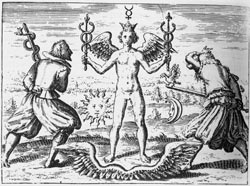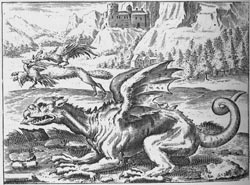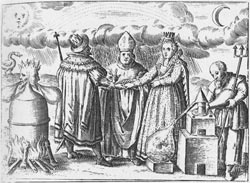
In 1936, the world of Isaac Newton scholarship received a rude shock. In that year the venerable auction house of Sotheby's released a catalogue describing three hundred twenty-nine lots of Newton's manuscripts, mostly in his own handwriting, of which over a third were filled with content that was undeniably alchemical. These manuscripts, which had been labeled "not fit to be printed" upon Newton's death in 1727, raised a host of interesting questions in 1936 as they do even today. Was the founder of classical physics an alchemist? And if so, what does this mean? Did he pursue his alchemical interests for scientific reasons, or simply because he was swept up by the old dream of transmuting base metals into gold? Did Newton discover a secret theological meaning in alchemical texts, which often describe the transmutational secret as a special gift revealed by God to his chosen sons? Or was Newton perhaps attracted to the graphic and mysterious imagery of alchemy, with its illustrations of hermaphrodites, couples copulating within flasks, poisonous dragons, green lions, and dying toads? None of these questions are made easier by the fact that Newton's laboratory notebooks, even the one containing the first full description of his brilliant discovery that white light is really a mixture of immutable spectral colors, are filled with recipes patently elaborated from the very alchemical sources that overflow the manuscripts sold by Sotheby's in 1936. Here too, alongside sober explanations of optical and physical phenomena such as freezing and boiling, we find "Neptune's Trident," "Mercury's Caducean Rod," and of course the "Green Lyon," all symbolizing substances derived from Newton's alchemical readings. Whatever the ultimate purpose of Newton's alchemical investigations may have been, it is clear that we cannot erect a watertight dam separating them from his other scientific endeavors.

We have adopted the seventeenth-century term "chymistry" to describe the sum of alchemical pursuits as they existed in Newton's day. In the early modern world, chymistry included three basic domains. First, chymists laid claim to a large group of technologies ranging from the making of pigments and dyes and the manufacture of mineral acids to the distillation of "strong waters" for drink. While often supporting themselves by making these items of commerce, however, chymical practitioners were also at the forefront of early modern pharmacology, having placed a radically new emphasis on mineral-based drugs and an equally important stress on the use of laboratory technologies such as distillation and sublimation in their production. Chymical medicine, or iatrochemistry, was one of the important new fields of early modern science, and the second basic division of the discipline. Third and finally, the attempt to make gold from less precious materials, often referred to by the Greek term chrysopoeia, remained a seemingly viable research project for many seventeenth century chymists. Newton was involved in all three of chymistry's major branches in varying degrees, and we make no attempt to impose an anachronistic division of the discipline into modern categories. It is important, rather, to see how chemical technology and medicine were connected to Newton's involvement to the "Great Work," just as it is important to see how his chymistry was related to his other intellectual and technical pursuits.

The Chymistry of Isaac Newton Project is devoted to the editing and exposition of Newton's alchemical work. With the support of the National Science Foundation and National Endowment for the Humanities, this project integrates an edition of Newton's alchemical manuscripts (for the most part previously unedited) in both diplomatic and normalized texts with new research on Newton's chymistry. In the future, the edition will include all of Newton's chymical writings in word-searchable form with annotations indicating their sources and the degree of Newtonian input into them. In addition, we are providing digital scans of Newton's chymical manuscripts, so that the reader can compare our transcriptions to the original handwriting and drawings in the manuscripts. The Chymistry of Isaac Newton is hosted by Indiana University's Digital Library Program, and is affiliated with The Newton Project based at the University of Sussex. For information about team members, please see the Project Team page.